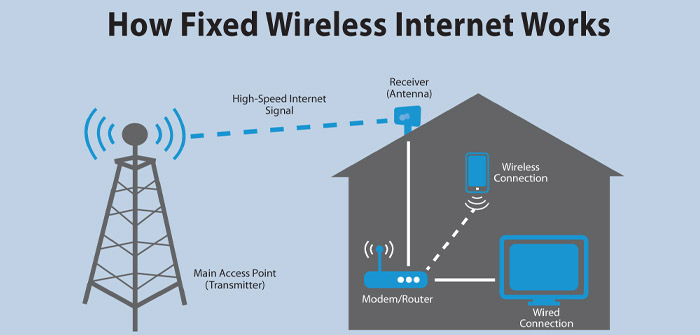(Graphic | Courtesy of Sureline Broadband)
In the competitive business and residential internet service landscape, overwhelming importance is being placed on maximizing efficiency, reliability and speed. Consumers now more than ever are dependent on their internet to facilitate work, school, communication, entertainment and social engagement. With so much of our lives reliant on the ability to connect to the internet and the frustration that quickly follows when a movie buffers, zoom call drops or the dreaded “sorry, no internet connection detected” message flashes across the screen we quickly wonder, “Is there a better way to connect to the internet!?” This might be a reach…. but a question worth asking.
Internet reliability is generally thought to be best accomplished by physical connectivity (i.e fiber optics and DSL). This notion is fundamentally being shifted by the advancement of Microwave Fixed Wireless Broadband technology. What sounds complicated, really is simple by nature and is pushing the boundaries of internet connectivity. Radio waves transmitted between two fixed stationary devices are providing commercial grade internet service that offers competitive internet speed, while reducing latency, increasing consistency and greatly improving reliability. Here’s how…
INTERNET SPEED — Fixed Wireless Internet offers the same speed capabilities as fiber optic cable. With small to mid-size businesses utilizing between 10mbps to 500mbps of internet, it is important to understand usage and need before signing up for service. When choosing a provider, it also important to know if they are delivering dedicated or shared bandwidth as this often determines quality of service. Dedicated bandwidth reserved solely for the use of one subscriber or business will provide speed consistency throughout the day while shared bandwidth service plans are split among all users resulting in “sluggish” peak hour performance.
REDUCED LATENCY — A less-talked-about element to internet performance that profoundly dictates speed is latency. In simple terms, latency is the delay in transmitting and processing data. In a city’s network, a fiber optic signal travels through many different points to complete the communication cycle. In contrast, a wireless signal is moving through a direct, line-of-site connection between two points minimizing “noise interruptions” or latency making the transmission of signal 50 percent faster!
INCREASED CONSISTENCY — Unfortunately, all internet providers are exposed to service interruptions or breaks. Network technicians work tirelessly around the clock to provide customers a consistent internet experience. Reports show that broadband usage is up 47 percent in Q1 2020 (largely due to the COVID-19 pandemic). Fact of the matter, network consistency and reliability are more important now than ever. Cable companies, vulnerable to physical cuts and downed power lines leave subscribers exposed to lengthy outages when problems arise. Fixed Wireless Broadband is capturing attention as both a redundant and primary internet solution due to built-in multipoint network redundancy delivering an “always on” service with close to 99.999 percent connectivity.
Available, affordable and reliable — Fixed Wireless Broadband Internet is making a case and answering the question for both business and residential customers: “What does the future of internet connectivity look like?”
surelinebroadband.com • lamont@surelinebroadband.com • 541-699-0030



